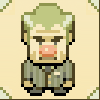
Here's another little illustration - something I made for a friend a week ago.
Click to have a look at the final image. But what's more important, I included another little Making Of in case you want to see how the piece came to be.
In any case, have fun viewing :)
 The first sketch was done in two layers of pencil.
The first sketch was done in two layers of pencil.Basically, the very general lines were laid out in normal pencil (meaning, the sheet pretty much ended up covered in grey...), with the final lines laid out in color - light blue for the body, orange for the dress, green for the wings, red for the hair. These aren't too visible in the scanned image (what with the contrast and brightness increased), but absolutely dominate the grey lines on paper.

You can also clearly see how I was too lazy to fully ink the image this time. But as a rule, it's a good idea to ink the focal point of the image at least. And by that, I mean her face.
The block-in phase was done with the pencil sketch laid over it in multiply.
I'm currently using SAI for my painting, and only the basic brushes and tools. The block-in was done with the pen tool, brushwork with the basic brush tool, middle round, no texture.

Note the light sources in yellow and blue.
Here's a little close-up of the same image, more or less. It's nice how you can see how I started modelling the face first and worked towards the rest.

You may have noticed how I painted the unused space in grey by hand instead of using the eraser tool. This was pretty much an experiment, but I think I'll keep doing it like that for things with a clear silhouette. Here's why:
 It's a lot of extra work, but I feel there's more control over the outline if you first draw towards a neutral tone, then add an outline (if desired), and then finish it off by erasing the outside. It basically means you work at any outline from both sides, but it makes for a cute "blotchy" effect and leaves you more control over the line weight.
It's a lot of extra work, but I feel there's more control over the outline if you first draw towards a neutral tone, then add an outline (if desired), and then finish it off by erasing the outside. It basically means you work at any outline from both sides, but it makes for a cute "blotchy" effect and leaves you more control over the line weight.Of course, if you're great enough to draw perfectly weighted lines digitally without help, then feel free to ignore this suggestion. And let me know how you do it :)
 This is a little closeup of the picture above.
This is a little closeup of the picture above.You can see pretty clearly how the image actually isn't detailed at all. I'm still hoping to develop a good consistency when it comes to masses and areas - meaning that I don't want certain spots to look overworked while others seem barren.
Well, the rest is pure painting work, nothing immensely creative. Just pick colors frequently, and check for values.
Please let me know if you'd like to have something explained more in detail.
In any case, thank you very much for reading. I hope you like it :)














0 comments:
Post a Comment